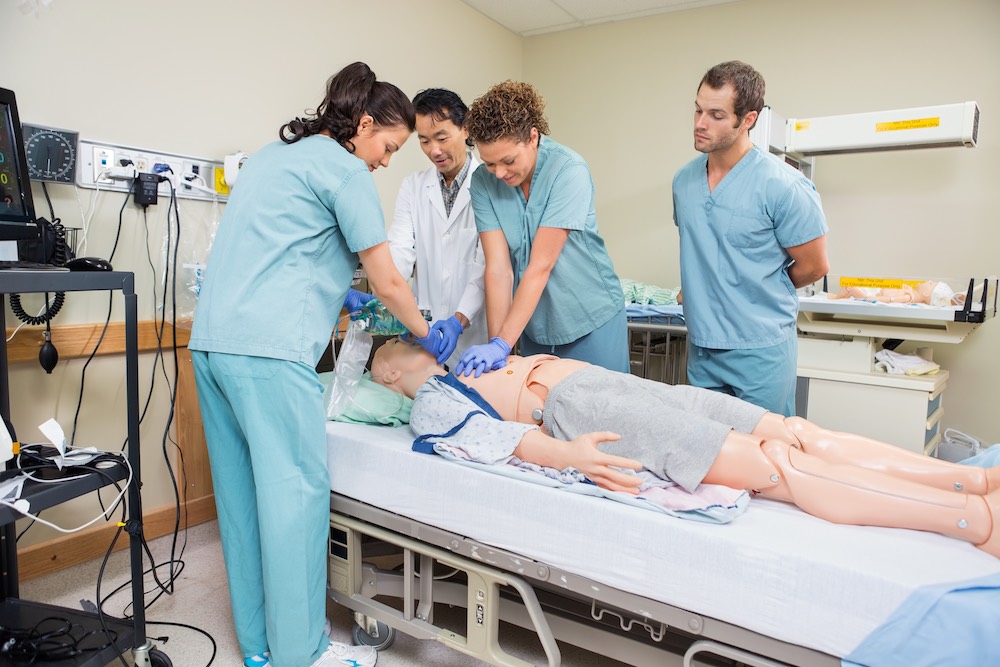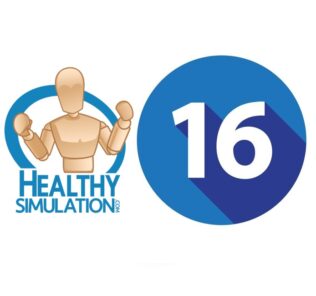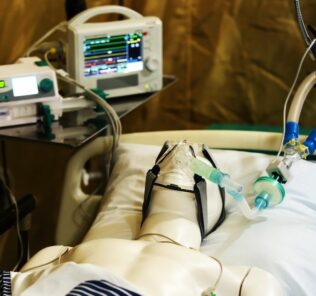New Clinical Simulation Center Updates | March 2023
Healthcare simulation centers are constantly being unveiled and upgraded across the United States and globally. As technology progresses, these clinical spaces are able to help transform how medical education and training are completed and have become integral to learners’ medical education within such clinical education buildings, medical centers, or training facilities devoted to healthcare simulation. Each new healthcare simulation center that opens provides even greater opportunities for learners to gain the skills and experience necessary to perform in the field and prioritize patient safety. This HealthySimulation.com article shares the most recent updates announced from various healthcare simulation centers around the world as of March 2023.
New Immersive Simulation Suite at UCF: According to the University of Central Florida, the College of Health Professions and Sciences has expanded the school’s state-of-the-art Rehabilitation Innovation Center with the addition of a new immersive, mixed reality room. The room will be used for both learner education and patient care. Further, the Blended Learning Interactive Simulation Suite, or BLISS, uses 270-degree, floor-to-ceiling touchscreen walls “that display curated video and audio, providing an immersive view of any event, location or experience — either real or created.”.
National Capital Region Simulation Consortium Earns Reaccreditation: According to the Walter Reed National Military Medical Center, The American College of Surgeons (ACS) recently reaccredited the National Capital Region Simulation Consortium, comprised of simulation centers at Walter Reed National Military Medical Center, Uniformed Services University, Fort Belvoir Community Hospital, and Malcolm Grow Medical Center at Joint Base Andrews, Maryland. The reaccreditation, achieved in October 2022, lasts for five years. The 5,000-square-foot facility includes the technology and protocols of real operating and exam rooms, in addition to a skills laboratory, an emergency room/intensive care unit, hands-on classroom training instruments, and an advanced audio-visual system.
Sponsored Content:
TROY Learners Observe Interprofessional Simulation Day
According to TROY University, nearly 100 social work and nursing learners participated in a joint medical Interprofessional Simulation Day in the school’s Health Sciences Simulation Center on Friday, Feb. 10. The learners experienced this opportunity alongside other healthcare learners from Wallace Community College-Dothan and the Alabama College of Osteopathic Medicine in Dothan. During the day-long event, learners from each institution “worked together to care for a standardized patient with the goal of gaining a better understanding of the roles and responsibilities each profession has in patient care.” Each healthcare simulation featured a patient, a family member, a social worker, a nurse, and a doctor.
IUPUC Simulation Center Earns Reaccreditation
According to The Republic, The Division of Health Services at Indiana University—Purdue University Columbus recently announced that its Simulation Center received reaccreditation from Simulation in Healthcare (SSH), making it one of only 100 labs worldwide to be fully accredited by SSH. The Simulation Center features a skills lab with eight patient care rooms, a clinical exam room, two simulation rooms divided by a control room with mirrored windows for viewing, realistic adult and pediatric manikins, and more.
Sponsored Content:
Covenant Health Pledges 10 Acres to Build New Health Science and Simulation Center
According to NBC News affiliate WBIR, Covenant Health has pledged to give 10 acres of land to the state of Tennessee to build a new Knox Regional Health Science and Simulation Center. The land is estimated to be worth around $10 million and is located in the 9000 block of Sherrill Boulevard, directly across the street from Parkwest Medical Center. The report states that the new health science and simulation center will focus on creating new spaces where instructors can give simulations of the work students will be doing when they graduate.
UMFK Plans New Immersive Interactive Simulation Center
According to the St. John Valley Times/Fiddlehead Focus, the opening of a new state-of-the-art immersive nursing simulation center this fall will further strengthen the University of Maine at Fort Kent’s nursing program. The goal is that this opening will allow for an expansion in enrollment and ensure graduates are even better prepared to meet the post-pandemic workforce and healthcare needs of the County and beyond. The immersive simulation center will be the first of its kind in New England and provide UMFK nursing students with hands-on clinical training to develop the skills necessary to facilitate positive patient outcomes, without risk.
Touro University Receives Simulation Accreditation
According to NBC affiliate SKNV, Touro University’s Michael Tang Regional Center for Clinical Simulation is now the only accredited simulation center for medical school students in the state of Nevada. The outlet reports that this distinction follows a $1 million investment to assemble four high-fidelity manikins that simulate patients in real-life situations including a heart attack and seizures. The manikins are also capable of sweating, crying, and talking with doctors.
LVHN Opens New Center for Healthcare Education
Lehigh Valley Health Network (LVHN) has officially cut the ribbon for the network’s new Center for Healthcare Education located at 3900 Sierra Circle, Center Valley. Now, the Center for Healthcare Education becomes the home of LVHN’s Department of Education and serves as the central hub of education and training programs for the health network. The facility consolidates two Department of Education sites into one 70,000-square-foot location with dedicated space for education, administration, and support services.
Human Patient Simulation Network (HPSN) India 2023
HPSN stands out as India’s premier purveyor of medical simulation training, dedicated to helping healthcare professionals sharpen their skills and knowledge through state-of-the-art, realistic simulations. The network’s advanced technology-equipped facilities offer an unparalleled, immersive learning experience that leaves no stone unturned. HPSN is also committed to propelling the realm of healthcare simulation education in India and beyond. By collaborating with leading organizations and hosting innovative conferences and events, the network is constantly pushing the envelope of what is possible in medical education.
Additional Healthcare Simulation Center Updates:
- Retirees Take on Roles of a Lifetime to Help Teach Aspiring Doctors at NYU Long Island School of Medicine
- Mobile simulation unit takes emergency responder training on the road to rural Missouri
- Onondaga Community College receives $2 million for new healthcare training center
More About Clinical Simulation Centers
Building a healthcare simulation center involves a huge amount of planning. All the stakeholders must come together and have input into the construction. The technical logistics and equipment are complex. For example, some healthcare simulation centers have simulation laboratories that exactly mimic an operating room, a delivery room, an emergency department, a medical-surgical floor room, an ICU room, etc. Experts from medical specialties and educators need to have input into the planning phase of the construction. Once the construction is complete, funds are needed for ongoing maintenance, repair, and replacement of equipment as the facility ages.
In many medical simulation training centers, the observation room serves as the debriefing room. In addition, there is usually a separate control room where the simulation technician sits. This is the person dubbed a Simulation Technology Specialist who remotely controls the manikin, such as the Laerdal SimMan3G, and who is responsible for setting up all the equipment and applying any special effects medical makeup called Moulage.
In addition, a clinical educator will be present in the control room. The educator, who often speaks the voice of the manikin controls the physiological and spoken responses of the manikin usually in response to the interventions of the learners within the sim lab. The setup below would be typical for a small simulation center.
Imagine a large-scale healthcare simulation center with multiple sim labs, control rooms, and debriefing. Add in patient examination rooms with standardized patients, rooms full of task trainers, banks of computers, and conference facilities, and the simulation center could easily occupy thousands of square feet.
These medical simulation centers cost millions of dollars to build and operate and are primarily found in large medical centers and universities. Funding for simulation centers can come from donations, grants, and university/medical center funding. Some simulation centers generate funds by renting out their spaces to other institutions or offering courses for which they charge a fee.
Learn More About Clinical Simulation Centers
Lance Baily, BA, EMT-B, is the Founder & CEO of HealthySimulation.com, which he started while serving as the Director of the Nevada System of Higher Education’s Clinical Simulation Center of Las Vegas back in 2010. Lance is also the Founder and acting Advisor to the Board of SimGHOSTS.org, the world’s only non-profit organization dedicated to supporting professionals operating healthcare simulation technologies. His co-edited Book: “Comprehensive Healthcare Simulation: Operations, Technology, and Innovative Practice” is cited as a key source for professional certification in the industry. Lance’s background also includes serving as a Simulation Technology Specialist for the LA Community College District, EMS fire fighting, Hollywood movie production, rescue diving, and global travel. He and his wife Abigail Baily, PhD live in Las Vegas, Nevada with their two amazing daughters.
Sponsored Content:




















